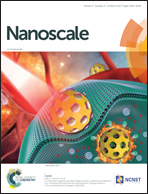Morphology memory but reconstructing crystal structure: porous hexagonal GeO2 nanorods for rechargeable lithium-ion batteries†
Abstract
Hexagonal GeO2, with high theoretical reversible capacity and low operating voltage, is regarded as a promising anode material for Li ion batteries. Being similar to other alloy type anode materials, the practical application of GeO2 is confronted with large volume change and fast capacity fading during lithiation/delithiation cycles. Constructing unique GeO2 nanostructures is proposed as an effective strategy to address this issue of fast capacity degradation. However, the controllable synthesis of GeO2 nanomaterials is challenged due to the fast hydrolysis of Ge precursors in aqueous solution. In this work, we report a simple strategy to synthesize GeO2 nanorods by using orthorhombic Ca2Ge7O16 nanorods as the sacrificial template with HNO3 as the etching agent. With the morphology memory of orthorhombic Ca2Ge7O16 nanorods, the as-prepared porous hexagonal GeO2 nanorods exhibit excellent electrochemical performance with a high capacity of 747 mA h g−1 after 50 cycles, which should be attributed to the porous and one dimensional nanostructure of GeO2 nanorods. This facile ‘morphology memory but restructuring crystal structure’ method could be extended to the controllable preparation of other GeO2 nanostructures, and achieve more efficient anode materials.



 Please wait while we load your content...
Please wait while we load your content...